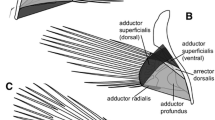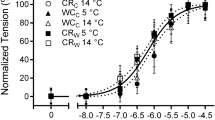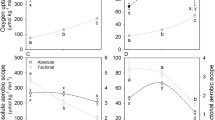Summary
The contractile properties of swimming muscles have been investigated in marine teleosts from Antarctic (Trematomus lepidorhinus, Pseudochaenichthys georgianus), temperate (Pollachius virens, Limanda limanda, Agonis cataphractus, Callionymus lyra), and tropical (Abudefduf abdominalis, Thalassoma duperreyi) latitudes. Small bundles of fast twitch fibres were isolated from anterior myotomes and/or the pectoral fin adductor profundis muscle (m. add. p). Live fibre preparations were viable for several days at in vivo temperatures, but became progressively inexcitable at higher or lower temperatures. The stimulation frequency required to produce fused isometric tetani increased from 50 Hz in Antarctic species at 0°C to around 400 Hz in tropical species at 25°C. Maximum isometric tension (Po) was produced at the normal body temperature (NBT) of each species (Antarctic, 0–2°C; North Sea and Atlantic, 8–10°C; Indo-West Pacific, 23–25°C). P0 values at physiological temperatures (200–300 kN·m−2) were similar for Antarctic, temperate, and tropical species. A temperature induced “tension hysteresis” was observed in muscle fibres from some species. Exposure to <0°C in Antarctic and <2°C in temperate fish resulted in the temporary depression of tension over the whole experimental range, an effect reversed by incubation at higher temperatures. At normal body temperatures the half-times for activation and relaxation of twitch and tetanic tension increased in the order Antarctic>temperate>tropical species. Relaxation was generally much slower at temperatures <10°C in fibres from tropical than temperate fish. Q10 values for these parameters at NBTs were 1.3 2.1 for tropical species, 1.7–2.6 for temperate species, and 1.6–3.5 for Antarctic species. The forcevelocity (P-V) relationship was studied in selected species using iso-velocity releases and the data below 0.8 P0 iteratively fitted to Hill's equation. The P-V relation at NBT was found to be significantly less curved in Antarctic than temperate species. The unloaded contraction velocity (Vmax) of fibres was positively correlated with NBT increasing from about 1 muscle fibre length·s−;1 in an Antarctic fish (Trematomus lepidorhinus) at 1°C to around 16 muscle fibre lengths·s−1 in a tropical species (Thalassoma duperreyi) at 24°C. It is concluded that although muscle contraction in Antarctic fish shows adaptations for low temperature function, the degree of compensation achieved in shortening speed and twitch kinetics is relatively modest.
Similar content being viewed by others
Abbreviations
- ET :
-
environmental temperature
- m. add. p :
-
major adductor profundis
- m. add. s. :
-
major adductor superficialis
- NBT :
-
normal body temperature
- P 0 :
-
maximum isometric tension
- P-V :
-
force velocity
- SR :
-
sarcoplasmic reticulum
- T 1/2 a :
-
half activation time
- T 1/2 r :
-
half relaxation time
- V max :
-
unloaded contraction
References
Altringham JD, Johnston IA (1988) The mechanical properties of polyneuronally innervated, myotomal muscle fibres isolated from a teleost fish (Myoxocephalus scorpius). Pflügers Arch 412:524–529
Altringham JD, Johnston IA (1990a) Modelling muscle power output in a swimming fish. J Exp Biol 148:395–402
Altringham JD, Johnston IA (1990b) Scaling effects on muscle function: power output of isolated fish muscle fibres performing oscillatory work. J Exp Biol 151:453–467
Archer SD, Johnston IA, (1989) Kinematics of labriform and subcarangiform swimming in the Antarctic fish Notothenia neglecta. J Exp Biol 143:195–210
Arntz W, Ernst W, Hempel I (1990) Reports on Polar Research. The expedition Antarktis VII/4 (Epos leg3) and VII/5 of Rv “Polarstern” in 1989. Alfred Wegener Institute for Polar and Marine Research, pp 152–158
Bennett AF (1985) Temperature and muscle. J Exp Biol 115:333–344
Bone Q (1978) Locomotor muscle. In: Hoar WS, Randall DJ (eds) Fish physiology Vol VII. Academic Press, New York and London, pp 361–424
Connell JJ (1958) Studies on the proteins of fish skeletal muscle 5. Molecular weight and shape of cod fibrillar proteins. Biochem J 70:81–91
Connell JJ (1961) The relative stabilities of skeletal muscle myosins of some animals. Biochem J 80:503–538
Davenport J (1990) Observations on the locomotion of post-larval and juvenile flying fish. J Mar Biol Ass UK 70:311–320
Edman KAP (1979) The velocity of unloaded shortening and it's relation to sarcomere length and isometric force in vertebrate muscle fibres. J Physiol (Lond) 291:143–159
Edman KAP, Mulieri LA, Scubon-Mulieri (1976) Non-hyperbolic force-velocity relationship in single muscle fibres. Acta Physiol Scand 98:143–156
Else PL, Bennett AF (1987) The thermal dependance of locomotor performance and muscle contractile function in the salamander Ambystoma tigrinum nebulosum. J Exp Biol 128:219–233
Harrison P, Nicol JM, Johnston IA (1987) Gross morphology, fibre composition and mechanical properties of pectoral fin muscles in the Antarctic teleost, Notothenia neglecta Nybelin. In: Kullander KO, Fernholm B (eds) Proceedings of the Fifth Congress on European Ichthyology, Stockholm 1985, pp#459–465
Hess F, Videler JJ (1984) Fast continuous swimming of saithe (Pollachius virens): a dynamic analysis of bending moments and muscle power. J Exp Biol 109:229–251
Hill AV (1938) The heat of shortening and dynamic constants of muscle. Proc R Soc Lond B 126:136–195
Hudson RCL (1969) Polyneuronal innervation of the fast muscles of the marine teleost Cottus scorpius L. J Exp Biol 59:47–67
John-Alder HB, Bennett AF (1987) Thermal adaptations in lizard muscle function. J Comp Physiol B 157:241–252
Johnson TP (1990) The influence of temperature on the mechanics and energetics of contraction in fish muscle. St Andrews University PhD thesis
Johnston IA (1981) Structure and function of fish muscles. Symp Zool Soc Lond 48:71–116
Johnston IA (1987) Respiratory characteristics of muscle fibres in a fish (Chaenocephalus aceratus) that lacks haem pigments. J Exp Biol 133:415–428
Johnston IA (1990) Cold adaptation in marine organisms. Phil Trans R Soc Lond B 326:655–667
Johnston IA, Altringham JD (1985) Evolutionary adaptation of muscle power output to environmental temperature: force velocity characeristics of skinned fibres isolated from Antarctic, temperate and tropical marine fish. Pflügers Arch 405:136–140
Johnston IA, Altringham JD (1988) Muscle function in locomotion. Nature Lond 335:767–768
Johnston IA, Brill R (1984) Thermal dependance of contractile properties of single skinned muscle fibres isolated from Antarctic and various Pacific marine fishes. J Comp Physiol B 155:63–70
Johnston IA, Harrison P (1985) Contractile and metabolic characteristics of muscle fibres from Antarctic fish. J Exp Biol 116:223–236
Johnston IA, Johnson TP, Battram JC (1990) Does low temperature limit burst swimming performance in Antarctic fish? In: The Italian National Programme for Antarctic Research (PNRA) and National Research Council (CNR) Second International Conference. Biology of Antarctic Fishes. Springer, Berlin Heidelberg New York (in press)
Johnston IA, Walesby NJ (1977) Molecular mechanisms of temperature adaptation in fish myofibrllar adenosine triphosphatases. J Comp Physiol 119:195–206
Kennett JP (1977) Cenozoic evolution of Antarctic glaciation, the circum-Antarctic ocean, and their impact on global paleoceanography. J Geophys Res 82:3843–3860
Langfeld KS, Altringham JD, Johnston IA (1989) Temperature and the force-velocity relationship of live muscle fibres from the teleost Myoxocephalus scorpius. J Exp Biol 144:437–448
Marsh RL, Bennett AF (1985) Thermal dependance of isotonic contractile properties of skeletal muscle and sprint performance of the lizard Dipsosaurus dorsalis. J Comp Physiol B 155:541–551
McArdle HJ, Johnston IA (1980) Evolutionary temperature adaptation in fish muscle sarcoplasmic reticulum. J Comp Physiol B 135:157–164
Montgomery JC, Macdonald JA (1984) Performance of motor systems in Antarctic fishes. J Comp Physiol A 154:241–248
Putnam RW, Bennett AF (1982) Thermal dependance of isometric contractile properties of lizard muscle. J Comp Physiol 147:11–20
Richards EG, Chung CS, Menzel DB, Olcott HS (1967) Chromatography of myosin on Diethylaminoethyl-Sephadex A-50. Biochemistry 6:528–540
Shann EW (1920) The comparative myology of the shoulder girdle and pectoral fin of fishes. Trans R Soc Edinb 52:531–570
Van Leeuwen JL, Lankheet MJM, Akster HA, Osse JWM (1990) Function of red axial muscles of carp (Cyprinus carpio) recruitment and normalised power output during swimming in different modes. J Zool Lond 220:123–145
Author information
Authors and Affiliations
Rights and permissions
About this article
Cite this article
Johnson, T.P., Johnston, I.A. Temperature adaptation and the contractile properties of live muscle fibres from teleost fish. J Comp Physiol B 161, 27–36 (1991). https://doi.org/10.1007/BF00258743
Accepted:
Issue Date:
DOI: https://doi.org/10.1007/BF00258743




